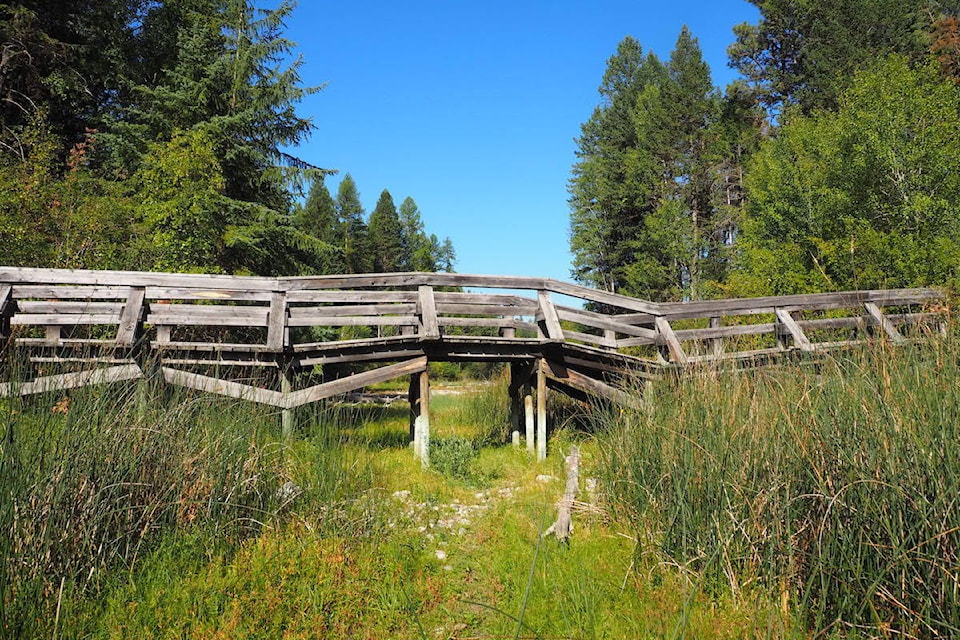A falling water table in the South Country has been a topic of discussion for years, with the most visible signs of water stress being the drastically low water at Baynes Lake and within Kikomun Creek Provincial Park.
One theory to explain the drought is that the water table is falling due to the aquifer in the area not being topped up by the Elko Dam, which was put under care and maintenance in 2016, leading to the water level of the head pond behind the dam falling.
The theory, which is supported by Stan Doehle of the Regional District of East Kootenay (RDEK), is that because the head pond is not high enough to fill sinkholes above the dam, the aquifer which flows under Bayles Lake, KikomunCreek and other lakes in the area is going dry.
Doehle believes that the decision by BC Hydro on the dam lines up with three years of consistent drops in the water level at Baynes Lakes and in the South Country, linking the two events. Another piece of evidence linking the water in the areas lakes to the Elk River is the selenium signatures in the water.
READ MORE: Officials raise alarm over water, environmental ‘crisis’ in Baynes Lake area
Local MLA, Tom Shypitka said he supports exploring the theory as it was sitting on pretty solid evidence.
“In the last three or four years the dam was put into care and maintenance and the water hasn’t reached full pool in the last three or four years, so that water hasn’t gotten to the sinkholes to refresh them. Since then, we’ve seen a substantial drop in the lake levels, at about two feet a year,” said Shypitka.
“We’re seeing a direct correlation between those sinkholes being dry, and a drop in the surrounding water bodies.”
Randal Macnair of local environmental group, Wildsight, said that there was plenty of credibility in exploring the link between the height of the dam and the water table, but added that broadly, the impacts of less water in the area was a result of climate change.
“The reality to this specific situation is that there’s multiple factors at play here. We’re presently at level 2 drought conditions. River levels are low, BC Hydro have been clear in the recent past that water levels are probably going to decrease as glaciers recede. It’s a climate change issue.
“As the folks in the South Country have noted, this has been happening for a number of years and its on the edge of hitting crisis point,” he said, adding that the evidence linking the aquifer going dry to the dam was yet another stressor for local communities.
Shypitka was optimistic that the issue was something that could be solved, especially given the evidence provided by Doehle.
“We’ve got really good scientific and practical evidence to support our claim, and if we’re wrong, then we’ll have to find out why this is happening by process of elimination. (The dam) seems to be the most obvious reason why the lake levels are dropping,” he said.
Options presented by Doehle on re-charging the aquifer include returning the head pond to its previous water level, creating a back-channel that would fill the sinkholes, or returning the river to its original course, which would allow it to re-charge the aquifer.
In a ministerial presentation made in early August, Doehle formally asked for the water level of the Elko Damn be returned to its previous levels, with an eye to observing the result of allowing the sinkholes to fill.
While BC Hydro has so far resisted the requests, saying that studies show no connection between the water levels at the dam and the water table, the community appears to have decided, with a change.org petition circulating in the community with over 3,000 signatures requesting BC Hydro do something to return water to the aquifer.
Doehle has most recently met with the B.C. Minister for Energy, Mines and Petroleum Resources, Bruce Ralston, to make the case that something must be done. He described it as a good meeting, and that he and the RDEK were waiting to hear back.
At stake, said Doehle, was the livelihoods of the entire community.
“Bottom line is we need a result, we need water,” he said.
While communities, businesses, tourism and industry in the area are reliant on the water of the aquifer, ecosystems are also being endangered by the falling water levels, including painted turtles that live within Kikomun Creek Provincial Park.
Macnair said that the reality was that the habitats within the park could well be lost if the water levels continue to fall.
“We’re talking about the impact of climate change. It’s not a ship that’s going to be righted in any short term, and we’re seeing changing ecosystems throughout the world. Whats happening with the turtles may well be a symptom of the impact we’ve had on the planet.
“We’ll work to try to steer that boat, however these are things that have been happening for decades, and unfortunately we’re at a point where we’re starting to see the ramifications of our actions,” he said.
“A turtle isn’t as charismatic as a polar bear, but the impact is no lesser.”
READ MORE: 87 hectares of old growth forests, wetlands in Pemberton now under conservancy protection
scott.tibballs@thefreepress.ca
Like us on Facebook and follow us on Twitter
